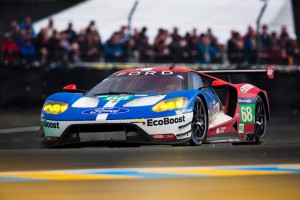If you weren’t quick enough to place an order for the new Ford GT supercar, you may get another chance, the maker announced during a news conference ahead of the annual Pebble Beach Concours d’Elegance.
Ford has already received more than 6,000 applications from prospective owners, a rare luxury in the car business, especially considering it was expecting to produce just 500 of the GTs for the 2017 and 2018 model-year. But the maker now plans to extend the production run, likely through at least 2020, and will re-open the order bank two years from now.
“While we can’t build enough Ford GTs for everyone who has applied, we are going to produce additional vehicles in an effort to satisfy more of our most loyal Ford ambassadors,” said Dave Pericak, global director, Ford Performance. “We want to keep Ford GT exclusive, but at the same time we know how vital this customer is to our brand.”
The decision to extend the Ford GT run certainly has its financial benefits considering the price tag is expected to top $400,000 – or 10 times as much as a reasonably well-equipped Ford Explorer. But there’s another factor behind the Detroit automaker’s decision.
Modeled after the race car that dominated the European endurance circuit in the 1960s, the new Ford GT has also been delivering trophies to the automaker. After a slow and technically troubled start at this year’s 24-hour race in Daytona, the GT came back strong and won its class at this year’s 24 Hours of Le Mans, one of the world’s most prestigious races.
And, according to a Ford statement, “Additional production supports Ford Performance decision to race Ford GT in both IMSA and World Endurance Championship (WEC) series for four years.” Ford had already said it would continue racing the GT through the end of the 2019 season.
(Ford makes Le Mans win available to virtually anyone. For more, Click Here.)
“Ford GT has racing in its blood,” said Raj Nair, Ford executive vice president, product development, and chief technical officer. “The road car and race car will live on, side-by-side, for the next four years — providing ample opportunity to test and prove innovative new technologies both on and off the track.”
What remains to be seen is whether there will be any significant updates to the street car when the order banks are reopened in 2018. There is little doubt that there will be notable updates to the race car. Ford has already tweaked that version to resolve some of the early problems that cost it so much time in the pits in early races, such as Daytona.
It would surprise few if there will be some clear improvements in performance and handling before the street version of the Ford GT ultimately ends its production run.
(Ford planning to launch first driverless car by 2021. Click Here for the story.)
While production isn’t set to begin until this autumn, the public response to the GT has been nothing short of overwhelming, more on a par with what an exotic manufacturer like Ferrari might experience, rather than a mainstream manufacturer such as Ford.
The maker specifically created what might be called an interview process to ensure each of the first batch of GTs would find a fitting home. Those who bought the GT model launched a decade ago got first shot. And Ford said it was taking steps to ensure buyers would actually drive their cars, not just park them and wait for the price to go up before reselling them.
(Cadillac Escala Concept reveals new design direction for Detroit brand. Click Here to check it out.)
Collectors have been bidding up the old GT models which now go for several times their original price in good condition.



I think this is a wonderful car and I am pleased to see that Ford is producing it. Having said that. If they announced when they offered it for sale that there would be just 500 built and selected customers from their 6000 applicants on the basis of a production run of just 500…Ford had better have a well oiled and high performance legal team.
When you advertise a limited build and increase that number you have changed the conditions under which the buyers have agreed to purchase the car. And, as increased production in virtually every category of product reduces scarcity…it promised to have a negative impact on the value of the product. Lawsuits are sure to follow, because the purchasers of these cars are acutely aware of the value they expect to enjoy from these cars…as well as the excitement of driving one.
If Ford wanted to produce more, the logical way would be to produce yet another series with some externally and internally identifiable design differences. This allows you to honor your contract with your first 500 buyers while allowing a second 500 buyers…or even 1000 if you announce that when it is offered for sale to have a different limited edition version of a Ford GT.
Simply producing additional volumes of a limited edition model is a guaranteed lawsuit.
Money talks…